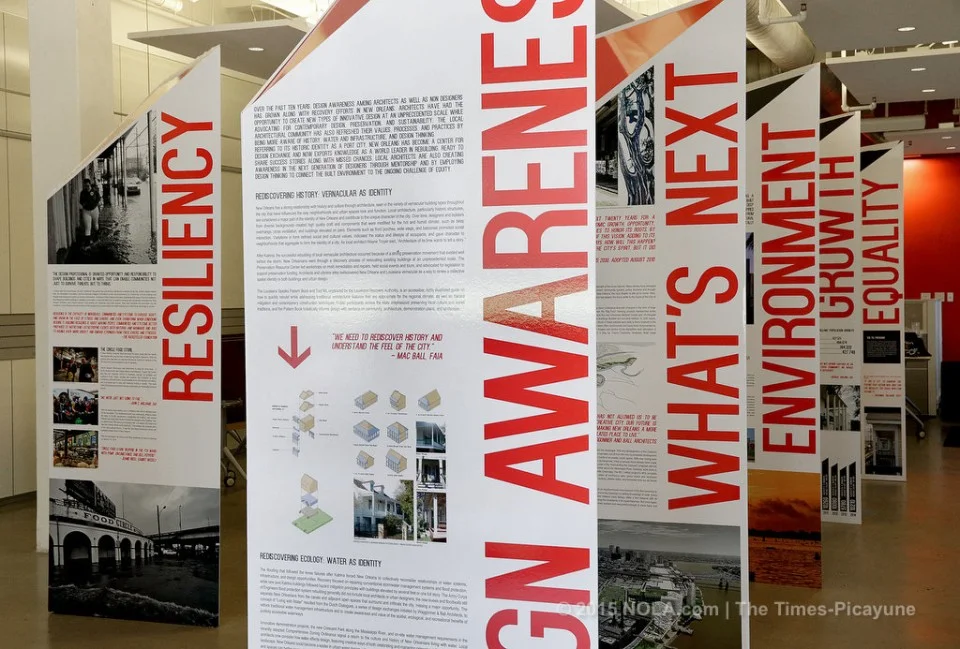10 Years / 10 Stories Exhibit on Display at University of Louisiana at Lafayette

In 2015, the 10 years/10 Stories: Architecture of Recovery Exhibit brought together emerging professionals from 7-8 firms to commemorate the years after Hurricane Katrina. The team was included various designers, from interns to newly licensed, and allied professionals that curated, designed, and planned the exhibit.“The 10 Years/10 Stories project focused on the spirit of engagement, dedication, and reciprocity of local architects to their communities.
The years after Katrina found architects in New Orleans taking political action, becoming nonprofit leaders, bringing environmental awareness to local practice, dedicating themselves to community engagement, and taking leadership positions on local councils.
The team engaged an even larger community of architects and groups outside of the profession to research and gather stories,” José Alvarez, Principal at Eskew+Dumez+Ripple describes. The 10-10 exhibit is currently exhibiting at Fletcher Hall in the University of Louisiana at Lafayette School of Architecture and Design. Sharing these personal stories about the past helped them launch a discussion on the future of the city, asking visitors, “What’s Next for New Orleans?”
“The resulting exhibit and panel discussion reflected the profession’s capacity and desire for collaboration. 10 Years/10 Stories created an opportunity to share this reflection with a larger community and to inspire the next generation of leaders charged with shaping the built environment."
”Reflecting on the experience, José adds, “We learned that, as a group, working collaboratively can bring an amazing result."
The following article originally appeared on NOLA.com last year.
Architects have left their mark on New Orleans since Hurricane Katrina, although in many cases it hasn't been obvious. If you don't notice a change when a historic building is renovated, for example, an architect likely had a hand in the project.
But what about new development and the opportunity it provides to designers to put their creative stamp on the cityscape? Can the two exist side by side?
Striking this balance is at the heart of "10 Years, 10 Stories," an exhibit at the American Institute of Architects New Orleans' headquarters on Lee Circle, where a White Linen Night reception will take place Saturday (Aug. 1).
The exhibit, conceived and executed by AIA New Orleans members, looks at how the profession responded in the years following the storm and levee failures. To cover the breadth of its contributions, organizers came up with 10 "storylines" or areas of concentration. They include policy, environment, community engagement and culture.
The exhibit consists of 10 pillars, or one for each storyline, that combine the words and work of local architects. For example, the community engagement pillar recounts how architects facilitated discussions on rebuilding during the weeks of uncertainty that followed the floodwaters receding from the city.
Concordia founder and principal Steven Bingler recalls this post-storm period as a time when architects came together and began to understand the role they would play in New Orleans' recovery.
"There has always been some concern that we, as a profession, were being respectful to historical tradition. But on the other hand, we didn't want to repeat history," Bingler said.
This extended to addressing the shortcomings of early recovery plans that left many voices unheard.
"The only way we can stay relevant as a city is to remain resilient. If you're not changing, you're not viable." - Amanda Rivera
"I think architects felt they had an obligation to ... find the most equitable outcome," said Amanda Rivera, an architect with Eskew Dumez Ripple who was part of the exhibit committee.
For Rivera, work on "10 Years, 10 Stories" brought back memories of the city's post-storm unity -- a time when architects and the entire community were committed to restoring what they missed most about New Orleans while attempting to ensure it would be able to withstand the next test.
The resiliency pillar of the exhibit addresses this challenge she said.
Miriam Salas, studio director for John T. Campo & Associates, helped compile contributions for the culture pillar. The Venezuela native came to New Orleans to study architecture at Tulane in 1996 -- and returned to the city twice after relocating -- and sees the city's architecture as reflection of its past as well as a door to the future.
Salas noted discussions about what type of architecture is culturally appropriate for New Orleans sound similar to accounts of opposition to the futuristic Louisiana Superdome as it was being designed and built in the early 1970s.
"Today, you would never hear about removing it," she said. "It's become a part of the city skyline."
Campo, the firm where Salas works, has been involved with a number of historical restoration projects but also handles more contemporary design projects. The two can -- and should -- co-exist, she said, with today's architects allowed to leave their thumbprint on the city.
"New architecture needs to belong to its time, while the past needs to be preserved," Salas said.
Organizers say the "10 Years, 10 Stories" exhibit provides more than just a look at progress since Katrina but also an entry point into ongoing conversations shaping New Orleans. Its policy pillar, for instance, looks at how architects have helped craft city ordinances and codes that will dictate new development.
Another pillar, "What Next?" allowed architects to look forward and express their vision of the future.
The online EP Exhibit will be available on new.aia.org starting Friday July 1, 2016. An announcement will be made to all AIA Emerging Professionals and the greater AIA membership in the next week. The physical EP Exhibit will be on display at AIA National Headquarters in Washington, D.C. from July 7, 2016 through September.



